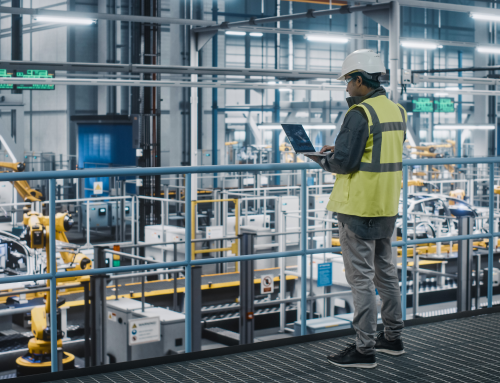Wireless Industrial IoT Sensors: The Future of IoT
A wireless industrial Internet of Things (IoT) sensor is a device that is capable of converting data into digital information and wireless transmission. Unlike the traditional wired sensors, they are able to transmit data wirelessly over long distances and do not need to be constantly monitored as they can store their own power.
Introduction
Wireless industrial IoT sensors are designed to collect data without the use of wires. They can detect and capture data in any situation, and have now found application in various sectors, including manufacturing/industrial sector.
Wireless industrial IoT sensors can be used to measure different output parameters of equipment sets, such as temperature, pressure, humidity and vibration among others. This is why these sensors find their application in almost all type of industries, be it cement, chemical, pharmaceutical or mobility.
Wireless industrial IoT sensors carry a tiny built-in radio transmitter and receiver, which means they can communicate with each other without being hard-wired together. This allows them to go further away from a power source and transmit more valuable information, such as the complex machine data.
They have made it possible to monitor machines, equipment sets or any other asset from anywhere in the world without needing to access the machine or environment manually. Data can also be transmitted directly from the sensor to an analytical dashboard for analysis and easy visual representation. In the recent years, a lot of industries have begun to take advantage of these new wireless sensors in order to improve their efficiency and generate more revenue, thereby enabling digital transformation of the manufacturing operations.

The need for wireless industrial IoT sensors
Industrial IoT sensors have been in use for a while now. They are used in various industries such as aviation, healthcare, logistics and many more. However, the traditional wired sensors have some major limitations – they need to be constantly monitored and can only transmit data over a short distance.
The wireless industrial IoT sensor has made it possible to overcome these problems of traditional wired sensors by allowing for long-distance wireless transmission of data and storing their own power. The wireless sensor is also able to send data directly from the sensor to an analytical dashboard where it can be analysed and visualised.

How wireless industrial IoT sensors work
The advancements in wireless industrial IoT sensors have led to a new approach towards condition monitoring and analytics. These new wireless sensors are able to transmit data wirelessly and store their own power, which means they can be installed easily even at remote and hard-to-reach places.
Since the sensors can be installed quickly & easily, they can be used to monitor many machines without any trouble. They can also collect more data than traditional wired sensors as there is no restriction on how often they can collect the data or how far they can transmit it. This facilitates real-time monitoring of the health of critical assets, to enable better operational oversight of the manufacturing operations.
These sensors are connected wirelessly to each other and to external platforms for data storage & analysis, using protocols such as Bluetooth, Wi-Fi or Cellular Networks. Wi-Fi and Cellular networks are also used to transfer data to the cloud for analysis.
Wireless industrial IoT sensor is a small device that has the ability to transmit data over long distances and will not need constant monitoring or maintenance. This is because it does not require an external power source. The use of these wireless Industrial IoT sensors to foresee the failure of assets in advance will empower the stakeholders from both the Top Floor and Shop Floor to make accurate decisions that has the potential to transform the entire manufacturing sector.

Applications of wireless industrial IoT sensors
- Wireless sensors are able to measure everything in the environment and transmit that data wirelessly. This can include environmental factors like temperature, pressure, humidity, air quality, noise levels or vibration. It can also be used to measure machine parameters like flow rate, speed or torque.
- Some of the industries that are beginning to use wireless industrial IoT sensors include Metals, Mining, Construction, Manufacturing, Oil and gas, Utilities, Nuclear power plants, Transportation, Logistics, Healthcare facilities etc.
- Wireless industrial IoT sensors are able to monitor machines and equipment sets from anywhere in the world, without needing physical access. For example, let’s say you work as a maintenance engineer. You could use these sensors to monitor how many hours of operation a machine has had and the temperatures it was exposed to. This information could help you determine when it is time for servicing or replacement of certain components.
- The data can either be transmitted directly from the sensor to an analytical dashboard for analysis and easy visual representation or uploaded into an FTP server or cloud-based storage system for retrieval at a later date, by third-party systems or the equipment owner. This is a great way for organizations to view their real-time data without having to physically access the machine or environment. The wireless transmission of data over long distances enables maintenance reliability professionals to track remote assets that were not previously possible with wired sensors.
Therefore, they offer the opportunity to scale the adoption of Industrial IoT at a faster pace, going from small-scale pilots to global rollouts in a very short span of time.

Conclusion
The Internet of Things (IoT) is gaining momentum and more and more industries are looking for ways to implement IoT solutions. Wireless industrial IoT sensors are a part of this trend and can be used in a variety of applications.
Wireless industrial IoT sensors provide an effective and affordable means of capturing the raw data from equipment and environments. They can be used to monitor equipment, such as generators, compressors, and turbines, as well as the environment such as storage tanks, pipelines, or any other asset. They will play a significant role in the future of the IoT because they are cost-effective and scalable.
Request a Call Back
Frequently Asked Questions

Let us show you how!
Explore the transformative potential of predictive maintenance. At Nanoprecise, we specialize in tailoring predictive maintenance to your unique needs. Reach out today, and together, let’s pave the way for a more efficient, profitable and sustainable future.
